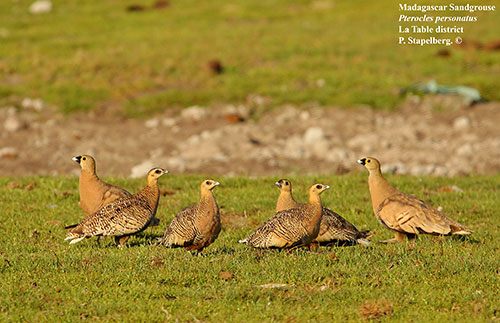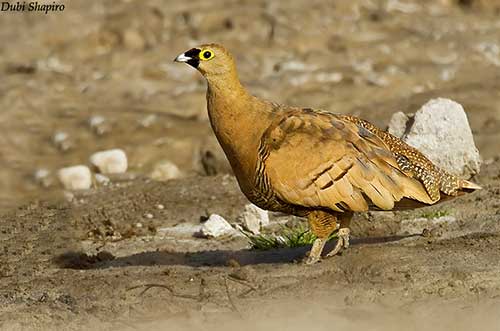
Until they are able to fly, the male brings water to the chicks into the soaked belly feathers that are specially adapted for carrying water. The female has less extended specialized area but she may help or replace the male if necessary.
The chicks grow rapidly and are completely fledged at about 3-4 weeks old, but they remain in family group for several months.
PROTECTION / THREATS / STATUS:
The Madagascan Sandgrouse is widespread and fairly common in W and S Madagascar, but it is patchily distributed in North.
The population is suspected to be stable and not globally threatened. The Madagascan Sandgrouse is currently evaluated as Least Concern.
Fr: Ganga masqué
Ang: Madagascan Sandgrouse
All: Madagaskarflughuhn
Esp: Ganga Malgache
Ita: Grandule del Madagascar
Nd: Madagaskarzandhoen
Sd: madagaskarflyghöna
Mal: Hatrakatrake, Katakatra, Katrakatraka
Photographers:
William Price
PBase-tereksandpiper & Flickr William Price
Dubi Shapiro
Dubi Shapiro Photo Galleries
Philip Stapelberg
GALLERY
Alan & Ann Tate
AA Bird Photography
Text by Nicole Bouglouan
Sources :
HANDBOOK OF THE BIRDS OF THE WORLD vol 4 by Josep del Hoyo-Andrew Elliott-Jordi Sargatal - Lynx Edicions - ISBN: 8487334229
The Birds of Africa: Volume VIII: The Malagasy Region: Madagascar, Seychelles, Comoros, Mascarenes - Par Roger Safford, Frank Hawkins – ISBN: 1408190494, 9781408190494- Editeur: A&C Black, 2013
Birds of Madagascar and the Indian Ocean Islands Par Roger Safford, Adrian Skerrett, Frank Hawkins – ISBN: 1472924118, 9781472924117- Editeur: Bloomsbury Publishing, 2015
Creagus – SANDGROUSE Pteroclidae
Sandgrouse - From Wikipedia, the free encyclopedia
Madagascan Sandgrouse
Pterocles personatus
Pterocliformes Order – Pteroclidae Family
INTRODUCTION:
The Madagascan Sandgrouse is endemic to Madagascar where it frequents savanna and wooded plains, and open spiny forest. It has a wide range in N, W and S of the island, but it occurs mainly in W and S where it favours hot, dry lowlands.
It feeds primarily on seeds throughout the year, but other plant matter such as leaves and shoots are also part of its diet. Sandgrouses are known to their regular flights to water due to their particularly dry diet.
The Madagascan Sandgrouse is not currently threatened and the species is common in W and S of the range.
DESCRIPTION OF THE BIRD:
Biometrics:
Length: 35 cm
The Madagascan Sandgrouse adult male has stocky body and broad, pointed wings. On the upperparts, mantle and scapulars are pinkish-brown with diffuse dark mottling formed by the greyish feather’s bases. Back, rump and uppertail-coverts are blackish-brown with buff spotting. The rectrices are blackish-brown with buff bars and tips.
On the upperwings, flight-feathers, primary coverts and alula are blackish-brown. The tertials are greyish-brown with buff outer webs. The greater coverts are buff with dark central streak, and the outer feathers have blackish tips. Median and lesser coverts are buff. The latter are tinged pinkish, and two narrow wingbars are formed by the black tips of the outermost lesser coverts.
On the underparts, lower chin and throat are buffy white, whereas upper breast and breast sides are pinkish-buff with pale barring, becoming much darker on centre of belly. The undertail-coverts are cinnamon. Underwing-coverts and axillaries are blackish-brown.

On the head, forehead, lores and chin are black, forming a dark mask. Crown and nape are pale pinkish-brown with indistinct dark barring. Supercilium, cheeks, ear-coverts, neck sides and hindneck are ochreous-buff.
The bill is pale blue. The eyes are brown, surrounded by yellow bare eyering. Strong legs and feet are greyish.
The cryptic plumage helps the bird to avoid predation, especially on the ground, among stones and bushes.
The female has blackish-brown upperparts, narrowly but heavily barred buff-brown. The crown is streaked cinnamon-buff and the hindneck shows mostly blackish streaks. Back, rump and uppertail-coverts are spotted buff. The upperwing is regularly and narrowly barred blackish. On the underparts, the upper breast is pinkish-buff with black barring at sides.
She has bluish-black bill.
The juvenile resembles female but it is duller, with very pale buff wings barred black. The upper breast is buff with dark brown spotting.
RANGE:
The Madagascan Sandgrouse is found in N, W and S Madagascar. It is rarer in far NW and absent from central plateau. It occurs from N of Mahajanga to Tôlagnaro.
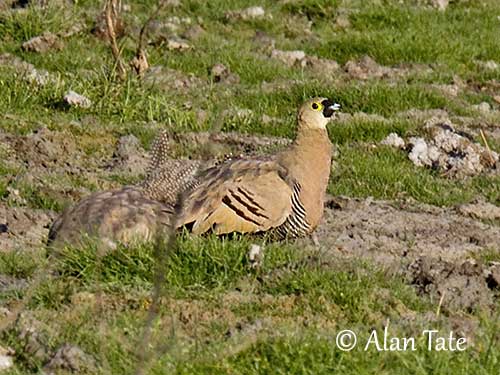
BEHAVIOUR IN THE WILD:
The Madagascan Sandgrouse feeds primarily on seeds, but it also consumes green shoots, leaves and berries. Some insects may be eaten during the breeding season.
It forages in slightly degraded or open spiny forest, or in grassy areas. It picks up most of the food off the ground.
It drinks usually in the early morning, although it can be found near water at other times of the day. They often drink in groups from 2-3 to 20-40 individuals, and occasionally much more, especially in dry season.
They fly to water while giving far-carrying calls, in order to attract congeners, involving sometimes huge flocks at drinking places.
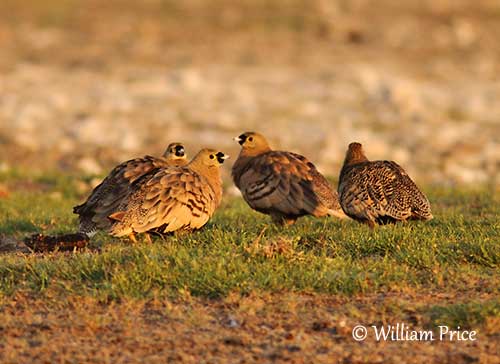
REPRODUCTION OF THIS SPECIES:
The breeding season coincide with a relative abundance of food (seeds), extending probably through late dry and early wet seasons in August-November, and again in early dry season in April/June.
The Madagascan Sandgrouse nests on the ground, in a scrape made in gravel, sand or hard ground. Some plant fibres can be added. It is placed on flat or slightly sloping ground, or under shrub, sometimes on lakeshores or on coastal beach. This species nests solitary or in loose colonies.
The female lays three well-marked, cryptic eggs. Both adults incubate, the male at night and the more cryptic female during the day. The change-overs are made unobtrusively and some distance away from the nest to avoid predation. The incubation usually lasts 20-25 days.
The chicks are precocial and leave the nest as soon as their down is dry. They have very cryptic colour. They can feed themselves 24 hours after hatching.
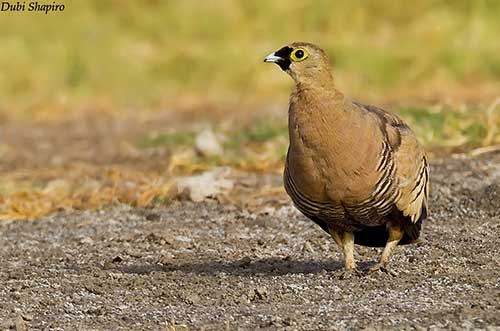
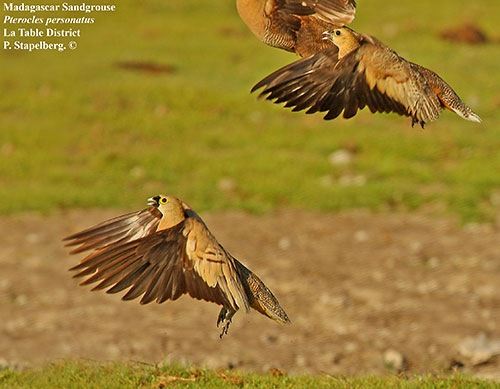
The Madagascan Sandgrouse is monogamous and has probably long-term pair-bonds. They breed in isolated pairs or in loose colonies. The courtship displays are not spectacular. The male holds the head low with the wings slightly open, while the tail is raised and fanned out. Prior to copulation, the male holds the legs very stiff and straight and the body erect while approaching the female. They nest on the ground and both adults share the nesting duties.
The Madagascan Sandgrouse is sedentary and only performs movements to find water. These birds can be seen flying about over all the country to reach rivers, lakes, ponds and water holes.
The flight is strong, sustained and direct, up to 30/100 metres up. The speed is calculated at close to 60-70 km an hour, and maintained over long distances.
HABITAT:
The Madagascan Sandgrouse occurs in open, dry areas such as savanna and wooded plains from sea-level up to 1,200 metres of elevation. It can be seen on sparsely vegetated ground or with rocks, and in slightly degraded and open spiny forest. It can be found near rivers and lakes with open margins.
CALLS AND SONGS: SOUNDS BY XENO-CANTO
The Madagascan Sandgrouse gives continuously contact calls in flight, a loud, clattering “ag-ag-ag-ag-ag-ag-ag” or “ak-ak-ak-ak-ak-ak-ak” rising slightly and becoming louder before falling again.
The Malagasy name “Katrakatraka” refers to this sound.
It also calls from the ground and usually gives a single or repeated note. The birds foraging on the ground give low calls, somewhat clucking in nature.
